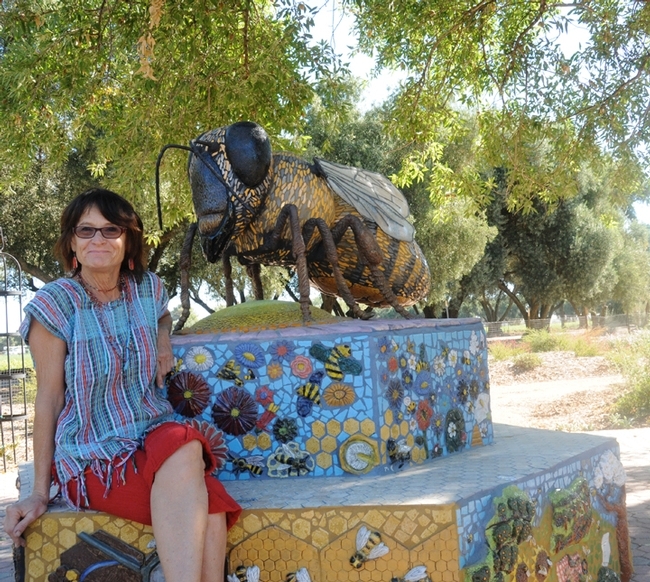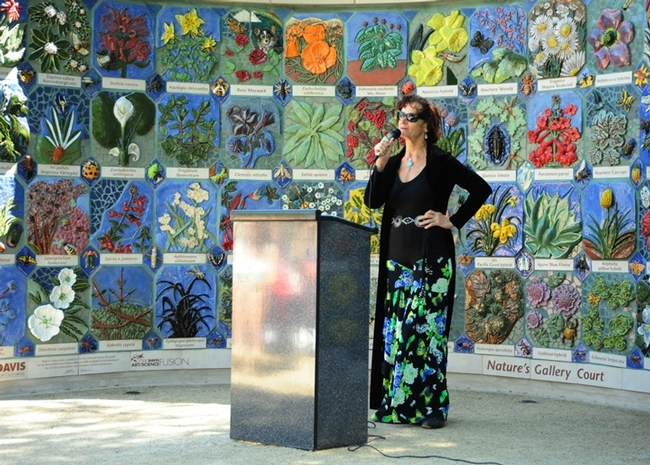- Author: Kathy Keatley Garvey

But of course, if you're curious about the work she does on fruit flies, you can interact with her on that as well as plant architecture!

The LASER, free and open to the public, will take place from 6:30 to 9 p.m. in Room 3001 of the Plant and Environmental Sciences Building. Anna Davidson, coordinator and moderator, says the April 14th event may be the last one on the UC Davis campus. (So, if you haven't attended one, you should!)
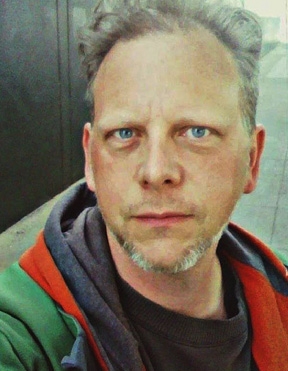
The other speakers:
Ian Pollock, assistant professor of art who directs the Graduate Multimedia Program at California State University, East Bay, will open the program from 7 to 7:25. His creative work with communications technologies is featured in several anthologies of digital media art. In addition to fruitful collaborations in Guerrilla Grafting, he is involved in mapping prejudice and developing an after-school program in neuroscience and game making. He holds a master of fine arts degree from UC Berkeley.
Anna Davidson will discuss her art work, “The Beauty of Ambiguity,” from 8:10 to 8:35. She is currently a master of fine arts candidate in Art Studio at UC Davis. She earlier received her doctorate from UC Davis in the Department of Plant Sciences where she studied plant ecophysiology.
Sarah Strand will cover “The Evolution of Religion” in her talk from 8:35 to 9 p.m. Strand teaches psychology classes at California State University, Sacramento. She holds a doctorate in behavioral neuroscience and has lectured on neurobiology topics (including religion, morality and love) for six years.
In her abstract, Strand says: “Darwin's theory of natural selection provides a spring board for a discussion about the evolution of ideas, including religion. From this perspective, the biopsychological origins of religion and atheism are discussed. Concluding statements focus on evidence of how religion has ‘survived' by expanding and adjusting to changes in culture, a.k.a. it's ‘environment.'”
The series of LASER events on the UC Davis campus are affiliated with the UC Davis Art/Science Fusion Program, co-founded by entomologist/artist Diane Ullman, professor of entomology, UC Davis Department of Entomoogy and Nematology, and self-described "rock artist" Donna Billick.
For more information, contact Anna Davidson at adavidson@ucdavis.edu or access the Facebook page at https://www.facebook.com/events/1715690135315290/
Related links:
http://www.leonardo.info/isast/laser.html
http://www.scaruffi.com/leonardo/
Map: http://www.plantsciences.ucdavis.edu/plantsciences/visitors/map.htm
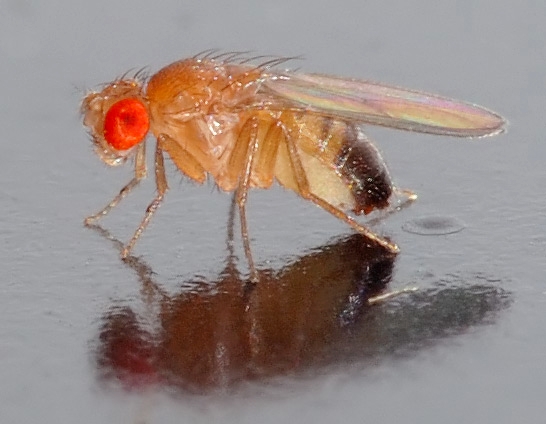
- Author: Kathy Keatley Garvey

Their colleague Anna Davidson, who recently received her doctorate at UC Davis in the Department of Plant Sciences and is now studying for her master of fine arts degree, organizes the UC Davis LASER events.
She's the person behind the scenes--and in front of the podium--who provides the speakers.
Her next event is from 7 to 9 p.m., Tuesday, Dec. 1 in Room 3001 of the Plant and Environmental Sciences Building. What a program she's lined up! Four speakers who fuse art with science will present 20-minute talks on several disciplines, including medicine, visual art and astrophysics.
The event is free and open to the public.
7 to 7:25 p.m.: Robert Lang, a scientist and artist known as one of the world's foremost origami artists, will speak on “From Flapping Birds to Space Telescopes: The Art and Science of Origami”
7:25 to 7:50 p.m.: Charlotte Jacobs, emeritus professor/physician at Stanford University who currently cares for cancer patients at the Palo Alto Veterans' Medical Center, will speak on "Jonas Salk and the Conquest of Polio.” She wrote a newly published biography on Jonas Salk (Jonas Salk: A Life), which, she says eradicated the crippling disease, but the scientific community never forgave him.
8:10-8:35 p.m.: Rachel Clarke, artist and educator teaching new media art at California State University, Sacramento, will cover “Merging Spaces,” about her latest art work, which combines physical and virtual modes of making
8:35-9 p.m.: Andreas Albrecht, professor and chair of the UC Davis Department of Physics, will discuss “What Is Time?” He is a leading theoretical physicist who specializes in understanding the origins of the universe will be talking about “time.”
More about Jacobs: She is the Ben and A. Jess Shenson Professor of Medicine (emeritus) at Stanford University. A native of Kingsport, Tenn., she studied medicine at Washington University, St. Louis. As a professor at Stanford University, she engaged in teaching, cancer research, and patient care. She received numerous awards for excellence in patient care and teaching, as well as the Distinguished Alumni Award from Washington University.
In his origami talk, Lang says he will discuss the techniques used in mathematical origami design, which range from the abstruse to the highly approachable. “I will describe the geometric concepts led to the solution of a broad class of origami folding problems – specifically, the problem of efficiently folding a shape with an arbitrary number and arrangement of flaps.” Lang holds a doctorate in applied physics from California Institute of Technology (Caltech), and during his work at NASA/Jet Propulsion Laboratory, Spectra Diode Laboratories, and JDS Uniphase, authored or co-authored more than 100 papers and 50 patents in lasers and optoelectronics as well as authoring, co-authoring, or editing 14 books and a CD-ROM on origami.
Clarke, whose topic is new media art, says her work combines physical and virtual modes of making. “As a comment on extreme consumerism in our contemporary lifestyle, the ephemeral works I create are often comprised of the waste products of that lifestyle – banal junk such as food packaging, advertising mailers, plastic bags – as well as discarded digital information. Through physical and digital processes, the discarded materials become contemplative artworks, in the form of experimental animations, augmented reality sculptures, and installations. While I'm using the technologies developed for 21st century capitalism, the way I'm using them becomes a critique of the corporate model of technology – a model designed for consumption of media, not creativity.”
Professor Albrecht says that “Time is a central part of everyday life, yet it can still seem very mysterious.” He will discuss time from a physicist's point of view “in a way that takes us from every day experiences to deep questions about the cosmos.” He is a member of the new Center for Quantum Mathematics and Physics at UC Davis.
In some of the previous UC Davis LASER events, speakers zeroed in on insects. There's an insect connection with the Dec. 1 event, too. Salk is often quoted as saying "If all the insects were to disappear from the Earth, within fifty years all life on Earth would end. If all human beings disappeared from the Earth, within fifty years all forms of life would flourish."
Did Salk say that? Probably not. No more than Albert Einstein said "If the bee disappeared off the surface of the globe, then man would have only four years of life left. No more bees, no more pollination, no more plants, no more animals, no more man.”
Related Links:
For more information on the program, see
https://www.facebook.com/events/1732840033613610/
For directions to the Plant and Environmental Sciences Building, see
http://www.plantsciences.ucdavis.edu/plantsciences/visitors/map.htm
Contact information:
Anna Davidson, adavidson@ucdavis.edu

- Author: Kathy Keatley Garvey

How did the mayfly wind up on the flowering artichoke? Well, there's a body of water close by--our fish pond.
Speaking of fish--not the kind in our pond, though--the UC Davis Art/Science Fusion Program is hosting a LASER-UC Davis event on Thursday night, Dec. 4 and one of the speakers is Chris Dewees, retired marine fisheries specialist, who fuses art with science. His topic: "Passion for Fish: When East Meets West."
The LASER event, free and open to the public, is scheduled from 6:30 to 9 p.m. in the Room 3001 conference room of the Plant and Environmental Sciences (PES) Building, UC Davis campus. LASER is an acronym for Leonardo Art Science Evening Rendezvous.
Dewees, a San Francisco native with a lifelong passion for fish, will speak from 8:10 to 8:35. His career has included commercial fishing and 35 years as the statewide marine fisheries specialist based at UC Davis.
When first exposed to the Japanese art of gyotaku, DeWees says he was "hooked." Gyotaku is the traditional method of Japanese fish printing, dating back to the mid-1800s.
His illustrated talk will offer insights into two-way communication between scientists and artists. "I will talk about how I can express my love of fisheries as a science-based career and as art."
"Combining my fisheries expertise with this art form gives me a very balanced life and a way to communicate my passion for fish to others," DeWees says. The art has led to shows and adventures around the world including the Smithsonian. Dewees received his bachelor of science degree from the University of Redlands in biology and speech; his master's degree from Humboldt State University in fisheries; and his doctorate at UC Davis in ecology.
Three other presentations will take place at LASER-UC Davis event. It's a good time to "bug out" of the house and attend.
The complete schedule:
6:30 to 7 p.m. Socializing and networking
7 to 7:25 p.m. Venkatesan Sundaresan, a plant sciences professor at UC Davis, will speak on “Mysteries of the Silent Kingdom: Sticking to One's Roots, Managing Hormones and Spreading Genes”
7:25 to 7:50 p.m. Robin Hill, art professor at UC Davis, will speak on “Idea Cultivation in the Studio.”
7:50 to 8:10 p.m. Break: Networking/socializing.
8:10 to 8:35 p.m. Chris Dewees, retired marine fisheries specialist at UC Davis, will speak on “Passion for Fish: When East Meets West."
8:35 to 9 p.m. Nanette Wylde, professor of art and art history at California State University, Chico, will speak on “Instigating Some Kind of Action: Interactive Projects Online and Off.”
The coordinator/moderator, Anna Davidson of the UC Davis Art/Science Fusion Program, received her Ph.D. earlier this year from UC Davis in plant sciences and is now seeking her master's degree in fine arts. She continues to study the biological world using both artistic and scientific approaches.
The UC Davis Art/Science Fusion Program was founded by entomologist/artist Diane Ullman, professor of entomology at UC Davis and her colleague, self-described "rock artist" Donna Billick, now retired. Their legacy--and that of the students they taught--is the mosaic ceramic art all over campus and beyond.

- Author: Kathy Keatley Garvey

Yes, plants can communicate.
And that's exactly what ecologist Rick Karban, professor of entomology, UC Davis Department of Entomology and Nematology, will discuss at the LASER-UC Davis (Leonardo Art Science Evening Rendezvous) event on Thursday night, Oct. 9 in Room 3001 of UC Davis Plant and Environmental Sciences Building.
Karban will speak on "Plant Communication" from 8:10 to 8:45. He is one of four speakers booked from 7 to 9 p.m. The event, free and open to the public, begins at 6:30 with socializing and networking. It is sponsored by the UC Davis Art/Science Fusion Program.
Karban drew international scientific and media attention with his research on “Kin Recognition Affects Plant Communication and Defense,” published in February 2013 in the Proceedings of the Royal Society B: Biological Sciences. He and four colleagues showed that kin have distinct advantages when it comes to plant communication, just as “the ability of many animals to recognize kin has allowed them to evolve diverse cooperative behaviors,” he told the UC Davis Department of Entomology and Nematology in a news release.
“When sagebrush plants are damaged by their herbivores, they emit volatiles that cause their neighbors to adjust their defenses,” Karban said. "These adjustments reduce rates of damage and increase growth and survival of the neighbors.”
“Why would plants emit these volatiles which become public information?” he asked. “Our results indicate that the volatile cues are not completely public, that related individuals responded more effectively to the volatiles than did strangers. This bias makes it less likely that emitters will aid strangers and more likely that receivers will respond to relatives.”
Karban was featured in Michael Pollan's piece on “The Intelligent Plant: Scientists Debate a New Way of Understanding Plants,” published last December in The New Yorker.” He is also spotlighted on YouTube.
A member of the UC Davis Department of Entomology and Nematology since 1982, Karban received his bachelor's degree in environmental studies from Haverford (Pa.) College, and his doctorate in biology from the University of Pennsylvania, Philadelphia.
He is a fellow of the American Association for the Advancement of Science (AAAS) and has published more than 100 journal articles and two books.
Other speakers at the Oct. 9th event are:
7 to 7:25 p.m.: Tami Spector, a professor of organic chemistry at the University of San Francisco, whose topic is “The Molecular Elusive."
7:25 to 7:50: Katharine Hawthorne, a San Francisco-based dancer and choreographer, who will discuss “Analog Bodies”
8:40 to 9: Cody Ross, a postdoctoral cultural and statistical anthropologist working at the Santa Fe Institute and UC Davis, whose topic is “Art Is Offensive: Integrative Art and Social Justice.”
The event promises to be educational and informative, according to moderator/organizer Anna Davidson ot the UC Davis Department of Plant Sciences, who recently received her doctorate. She studies fruit tree ecophysiology and is an instructor with the UC Davis Art Science Fusion Program.

- Author: Kathy Keatley Garvey

It's a program that, as the name indicates, fuses art and science. Science with art.
On that note, two noteworthy events sponsored by the program will take place next week.
But first, what's the program all about?
It's the brainchild of UC Davis entomologist/artist Diane Ullman and her close friend and colleague Donna Billick, a self-described "rock artist." Their visions and talents are absolutely amazing and have drawn national and international attention.
Ullman and Billick began teaching classes in the UC Davis Department of Entomology (now Entomology and Nematology) in the mid-1990s that led to the formation of the Art/Science Fusion Program. They founded the program and now serve as co-directors. Today it includes design faculty, science faculty, museum educators, professional artists and UC Davis students.
“Participants see and feel art and science, hold it in their hands, hearts and memories—in ceramics, painting, photographs, music, and textiles,” said Ullman, professor of entomology, former chair of the UC Davis Department of Entomology, and former associate dean for Undergraduate Academic Programs, UC Davis College of Agricultural and Environmental Sciences.
Basically, it's an innovative teaching program that "crosses college boundaries and uses experiental learning to enhance scientific literary for students from all disciplines." The program promotes environmental literacy with three undergraduate courses, a robust community outreach program, and sponsorship of the Leonardo Art Science Evening Rendezvous (LASERs).
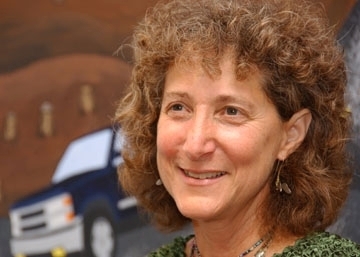
One of the UC Davis Art/Science Fusion Program's most visible and “wow!” projects is the 2,500 pound mosaic art, Nature's Gallery in the Storer Garden, UC Davis Arboretum. It showcases the interaction--and the beauty--of insects and plants. It was initially displayed at the U.S. Botanical Garden in Washington D.C. and at the California State Fair.
Another project that draws much attention and acclaim is the Ent 1 art in the Häagen-Dazs Honey Bee Haven, a half-acre bee garden on Bee Biology Road, west of the central campus.
Billick created “Miss Bee Haven,” a six-foot-long honey bee sculpture that anchors the garden. "I like to play with words,” said Billick. She also created the colorful Harry H. Laidlaw Jr. Honey Bee Research Facility's mosaic ceramic sign that features DNA symbols and almond blossoms. A hole drilled in the sign is ready for a bee hive.
Also in Davis, Billick created the whimsical Dancing Pigs sculpture and the Cow Fountain, both in the Marketplace Shopping Center on Russell Boulevard; the Mediation sculpture at Central Park Gardens; and the Frawns for Life near the West Area Pond.
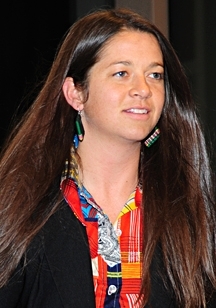
Billick traces her interest in an art career to the mid-1970s when then Gov. Jerry Brown supported the arts and offered the necessary resources to encourage the growth of art. He reorganized the California Arts Council, boosting its funding by 1300 percent.
She maintains a compound in Baja, where she teaches three workshops a year called "Heaven on Earth." She has won numerous awards for her work.
For outstanding teaching, Diane Ullman was recently selected the recipient of the 2014 Distinguished Award in Teaching from the Pacific Branch, Entomological Society of America. She is now one of six candidates for the ESA Distinguished Teaching Award. ESA will select the recipient from one of six branches—Pacific, Eastern, North Central, Southeastern, Southwestern and International—and present the award at its Nov. 16-19 meeting in Portland, Ore.
The other noteworthy event involving the UC Davis Art/Science Fusion Program occurs on Monday, June 2. It's the popular LASER-UC Davis event and will be held from 6:30 to 9:30 p.m. in Room 3001 of the Plant and Environmental Sciences Building. (LASER is an acronym for Leonardo Art Science Evening Rendezvous.) One of the program's teachers, Anna Davidson, a Ph.D candidate in the UC Davis Department of Plant Sciences, is coordinating and moderating the event. Come by at 6:30 for socializing and networking. The program starts at 7.
Davidson has gathered an exciting program of four speakers, with a discussion and more networking to follow from 9 to 9:30:
The schedule:
- Gene Felice, graduate student, at the University of California Santa Cruz, will speak on "Justice in a More Human World" from 7 to 7:25.
- Michael Neff, associate professor in Computer Science and Cinema and Technocultural Studies at UC Davis, will speak on "The Gap Between Computational and Artistic Models of Movement"
- Danielle Svehla Christianson of the Berkeley Center for New Media, will discuss "The Gap Between: Computational and Artistic Models of Movement, “A Digital Forest: 01100110 01101111 01110010 01100101 01110011 01110100” from 8:10 to 8:35 p.m.
- Joe Dumit, director of Science and Technology Studies and professor of anthropology at UC Davis, will speak on "Haptic Creativity: Seeing, Scaling and Storymaking with the KeckCAVES" from 8:35 to 9 p.m.
